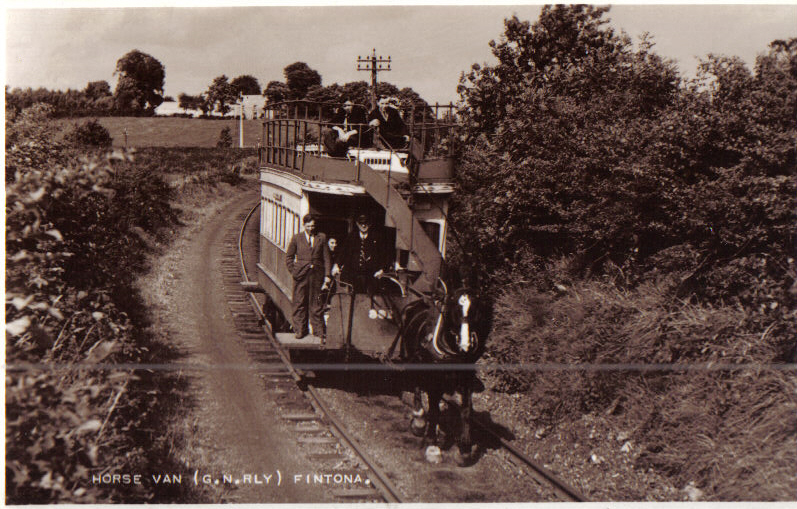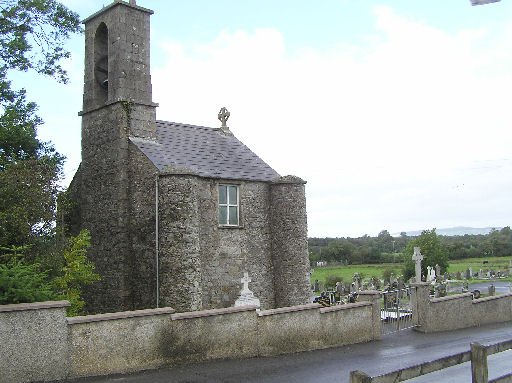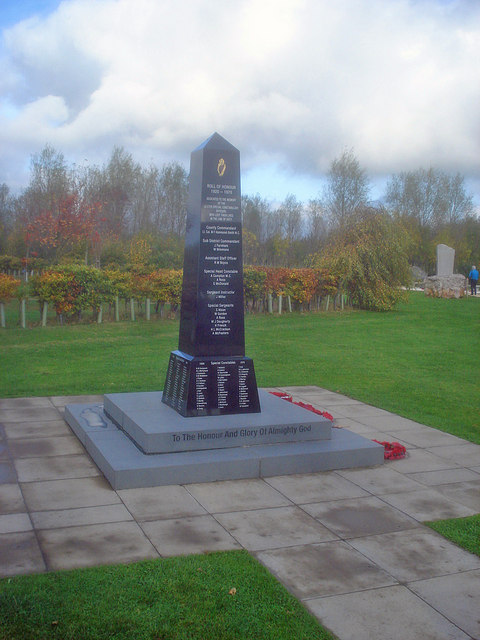|
Dromore, County Tyrone
Dromore () is a village, townland and civil parish in County Tyrone, Northern Ireland. It is nine miles (15 km) south west of Omagh on the A32 and sixteen miles (26 km) from Enniskillen. The population of Dromore was 1,198 at the 2011 Census. This article contains quotations from this source, which is available under th Open Government Licence v3.0 © Crown copyright. History The town was originally built in 1757 when the then Lord of the manor, William Hamilton, of Aughlish House gave a grant of the townland of Mullinacross, now called Dromore, to two families - Stewart and Humphreys. The town at that time consisted of only four houses. The original name of the townland is derived from an ancient stone cross which formerly stood on the top of the hill overlooking the town, and near to where the Cistercian Abbey was located. This abbey which was destroyed by a fire in 1690 is said to have been built on the site of a nunnery founded by Saint Patrick for Saint Cettu ... [...More Info...] [...Related Items...] OR: [Wikipedia] [Google] [Baidu] |
2011 United Kingdom Census
A census of the population of the United Kingdom is taken every ten years. The 2011 census was held in all countries of the UK on 27 March 2011. It was the first UK census which could be completed online via the Internet. The Office for National Statistics (ONS) is responsible for the census in England and Wales, the General Register Office for Scotland (GROS) is responsible for the census in Scotland, and the Northern Ireland Statistics and Research Agency (NISRA) is responsible for the census in Northern Ireland. The Office for National Statistics is the executive office of the UK Statistics Authority, a non-ministerial department formed in 2008 and which reports directly to Parliament. ONS is the UK Government's single largest statistical producer of independent statistics on the UK's economy and society, used to assist the planning and allocation of resources, policy-making and decision-making. ONS designs, manages and runs the census in England and Wales. In its capacity as t ... [...More Info...] [...Related Items...] OR: [Wikipedia] [Google] [Baidu] |
Protestantism
Protestantism is a branch of Christianity that follows the theological tenets of the Protestant Reformation, a movement that began seeking to reform the Catholic Church from within in the 16th century against what its followers perceived to be growing errors, abuses, and discrepancies within it. Protestantism emphasizes the Christian believer's justification by God in faith alone (') rather than by a combination of faith with good works as in Catholicism; the teaching that salvation comes by divine grace or "unmerited favor" only ('); the priesthood of all faithful believers in the Church; and the ''sola scriptura'' ("scripture alone") that posits the Bible as the sole infallible source of authority for Christian faith and practice. Most Protestants, with the exception of Anglo-Papalism, reject the Catholic doctrine of papal supremacy, but disagree among themselves regarding the number of sacraments, the real presence of Christ in the Eucharist, and matters of ecclesiast ... [...More Info...] [...Related Items...] OR: [Wikipedia] [Google] [Baidu] |
Catholic
The Catholic Church, also known as the Roman Catholic Church, is the largest Christian church, with 1.3 billion baptized Catholics worldwide . It is among the world's oldest and largest international institutions, and has played a prominent role in the history and development of Western civilization.O'Collins, p. v (preface). The church consists of 24 ''sui iuris'' churches, including the Latin Church and 23 Eastern Catholic Churches, which comprise almost 3,500 dioceses and eparchies located around the world. The pope, who is the bishop of Rome, is the chief pastor of the church. The bishopric of Rome, known as the Holy See, is the central governing authority of the church. The administrative body of the Holy See, the Roman Curia, has its principal offices in Vatican City, a small enclave of the Italian city of Rome, of which the pope is head of state. The core beliefs of Catholicism are found in the Nicene Creed. The Catholic Church teaches that it is th ... [...More Info...] [...Related Items...] OR: [Wikipedia] [Google] [Baidu] |
Great Britain
Great Britain is an island in the North Atlantic Ocean off the northwest coast of continental Europe. With an area of , it is the largest of the British Isles, the largest European island and the ninth-largest island in the world. It is dominated by a maritime climate with narrow temperature differences between seasons. The 60% smaller island of Ireland is to the west—these islands, along with over 1,000 smaller surrounding islands and named substantial rocks, form the British Isles archipelago. Connected to mainland Europe until 9,000 years ago by a landbridge now known as Doggerland, Great Britain has been inhabited by modern humans for around 30,000 years. In 2011, it had a population of about , making it the world's third-most-populous island after Java in Indonesia and Honshu in Japan. The term "Great Britain" is often used to refer to England, Scotland and Wales, including their component adjoining islands. Great Britain and Northern Ireland now constitute the ... [...More Info...] [...Related Items...] OR: [Wikipedia] [Google] [Baidu] |
Fintona
Fintona (; ), is a village and townland in County Tyrone, Northern Ireland. Its population at the 2011 Census was 1,164. Name and etymology Fintona is derived phonetically from the Irish name of the area, ''Fionntamhnach''; this is often translated to mean "white field" however other meanings have been recorded due to various English translations for "fionn" and "tamhnach". "Fionn" may refer to a colour that is described as white, bright, blonde or fair-coloured, while "tamhnach" may refer to a field, clearing, oasis, grassy upland or arable place in a mountain. In the past, the English spelling of the area has varied, with ''"Findonagh"'' in use as recently as 1937 in Church of Ireland documents, while ''"Fentonagh"'' and ''"Fintonagh"'' were also in use in the 19th century. The current spelling of Fintona has been recorded as first used in 1774. History The local area has been known to have had human activity for around 4000 years; there are many burial places, standing ston ... [...More Info...] [...Related Items...] OR: [Wikipedia] [Google] [Baidu] |
Ederney
Ederney () is a village situated primarily in the townlands of Drumkeen and of Ederny in County Fermanagh, Northern Ireland. At the 2011 Census it had a population of 587. This article contains quotations from this source, which is available under th Open Government Licence v3.0 © Crown copyright. Ederney lies in the Glendarragh River Valley near Lower Lough Erne and Kesh. It is from Belfast, over from Dublin and about 16 miles from both Omagh and Enniskillen. The village and its hinterland (the Glendarragh Valley area) has a population of several thousand.History of Ederney (Ederny) , ederney.com; accessed 3 February 2016. Due to Ederney's position adjacent to the village is located on a tourist ... [...More Info...] [...Related Items...] OR: [Wikipedia] [Google] [Baidu] |
Trillick
Trillick () is a small village in County Tyrone, Northern Ireland. It had a population of 2,439 people in the 2011 Census. Trillick is in the Civil Parish of Kilskeery, Barony of Omagh East. It is located within the Diocese of Clogher (both Roman Catholic and Church of Ireland). History Early history Trillick ''Trí Leac'' (in Irish) “three stones”, is another term for a chambered tomb. The village is named from a ruined example beside Trillick Castle. The name is referred to in early records as Trelic and Trelic Mor, taking that name from the three pillars or standing stones located at what was the original Trelic and now generally referred to as the Old Castle. After 4,000 years, the three pillar stones and a stone doorway facing the rising sun, can be seen. It is believed to be a settlement of the Beaker people, who came from the Netherlands to Britain and then to Ulster around 2,000 B.C. They were skilled in making decorative gold, copper and metal objects and th ... [...More Info...] [...Related Items...] OR: [Wikipedia] [Google] [Baidu] |
Drumquin
Drumquin (Irish: ''Droim Caoin'' (Pleasant ridge).) is a small village and townland (of 398 acres) in County Tyrone, Northern Ireland. It lies between Omagh and Castlederg, on the banks of the Drumquin River (Fairywater). It is situated in the civil parish of Longfield West and the historic barony of Omagh West. It had a population of 291 people in the 2001 Census. History It has a rich and varied historical legacy with a Neolithic stone circle, a Holy Well, and the Giant's Stone on Dooish Mountain. The works of the noted Irish writer Benedict Kiely contain many references to the Drumquin district, with which he had family connections on his mother's side. In 1802, the countryside around Drumquin was described as one continuous scene of dreary mountains. However, the traveler did point out that forty years before that a rich coalmine had been opened at Drumquin and a canal opened to transport the coal. Drum quin has been in existence since 1211. Sir John Davies founded the ... [...More Info...] [...Related Items...] OR: [Wikipedia] [Google] [Baidu] |
Ulster Special Constabulary
The Ulster Special Constabulary (USC; commonly called the "B-Specials" or "B Men") was a quasi-military reserve special constable police force in what would later become Northern Ireland. It was set up in October 1920, shortly before the partition of Ireland. It was an armed corps, organised partially on military lines and called out in times of emergency, such as war or insurgency. It performed this role most notably in the early 1920s during the Irish War of Independence and the 1956-1962 IRA Border Campaign. During its existence, 95 USC members were killed in the line of duty. Most of these (72) were killed in conflict with the IRA in 1921 and 1922. Another 8 died during the Second World War, in air raids or IRA attacks. Of the remainder, most died in accidents but two former officers were killed during the Troubles in the 1980s. The force was almost exclusively Ulster Protestant and as a result was viewed with great mistrust by Catholics. It carried out several revenge ... [...More Info...] [...Related Items...] OR: [Wikipedia] [Google] [Baidu] |
Royal Irish Constabulary
The Royal Irish Constabulary (RIC, ga, Constáblacht Ríoga na hÉireann; simply called the Irish Constabulary 1836–67) was the police force in Ireland from 1822 until 1922, when all of the country was part of the United Kingdom. A separate civic police force, the unarmed Dublin Metropolitan Police (DMP), patrolled the capital and parts of County Wicklow, while the cities of Derry and Belfast, originally with their own police forces, later had special divisions within the RIC. For most of its history, the ethnic and religious makeup of the RIC broadly matched that of the Irish population, although Anglo-Irish Protestants were over-represented among its senior officers. The RIC was under the authority of the British administration in Ireland. It was a quasi-military police force. Unlike police elsewhere in the United Kingdom, RIC constables were routinely armed (including with carbines) and billeted in barracks, and the force had a militaristic structure. It policed Irela ... [...More Info...] [...Related Items...] OR: [Wikipedia] [Google] [Baidu] |
Irish Republican Army (1919–1922)
The Irish Republican Army (IRA; ga, Óglaigh na hÉireann) was an Irish republican revolutionary paramilitary organisation. The ancestor of many groups also known as the Irish Republican Army, and distinguished from them as the "Old IRA", it was descended from the Irish Volunteers, an organisation established on 25 November 1913 that staged the Easter Rising in April 1916. In 1919, the Irish Republic that had been proclaimed during the Easter Rising was formally established by an elected assembly (Dáil Éireann), and the Irish Volunteers were recognised by Dáil Éireann as its legitimate army. Thereafter, the IRA waged a guerrilla campaign against the British occupation of Ireland in the 1919–1921 Irish War of Independence. Following the signing in 1921 of the Anglo-Irish Treaty, which ended the War of Independence, a split occurred within the IRA. Members who supported the treaty formed the nucleus of the Irish National Army. However, the majority of the IRA was opposed to ... [...More Info...] [...Related Items...] OR: [Wikipedia] [Google] [Baidu] |
Irish War Of Independence
The Irish War of Independence () or Anglo-Irish War was a guerrilla war fought in Ireland from 1919 to 1921 between the Irish Republican Army (IRA, the army of the Irish Republic) and British forces: the British Army, along with the quasi-military Royal Irish Constabulary (RIC) and its paramilitary forces the Auxiliaries and Ulster Special Constabulary (USC). It was part of the Irish revolutionary period. In April 1916, Irish republicans launched the Easter Rising against British rule and proclaimed an Irish Republic. Although it was crushed after a week of fighting, the Rising and the British response led to greater popular support for Irish independence. In the December 1918 election, republican party Sinn Féin won a landslide victory in Ireland. On 21 January 1919 they formed a breakaway government (Dáil Éireann) and declared Irish independence. That day, two RIC officers were killed in the Soloheadbeg ambush by IRA volunteers acting on their own initiative. The conf ... [...More Info...] [...Related Items...] OR: [Wikipedia] [Google] [Baidu] |

.jpg)








